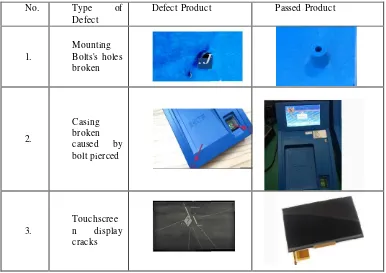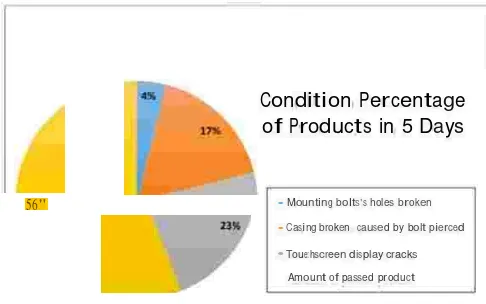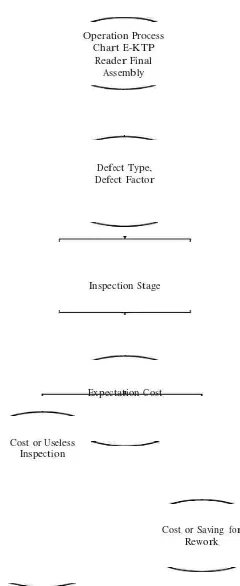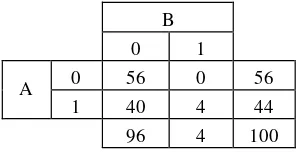INSPECTION SCENARIO FOR E-KTP READER FINAL ASSEMBLY BASED ON
EFFICIENT COST ASSOCIATE IN THE PRODUCTION DIVISION IN PT. ABC
Nabilatushalihah Rahandari Heruputri 1, Wiyono Sutari2, Marina Yustiana Lubis3
1
Program Studi Teknik Industri, Fakultas Rekayasa Industri, Universitas Telkom
Email : 1nabila.heruputri@gmail.com 2wiy2606@gmail.com 3marina.irawan@gmail.com
Abstract
PT. ABC produces one of their electronic equipment, known as E-KTP Reader. In the production of E- KTP Reader, there are so many defect products which found at final assembly process. The main defect that usually occurs in the product are touchscreen display cracks, casing broken caused by bolt pierced,
and mounting’s bolts holes broken. Based on the information of the company in Operation Process Chart,
there is only one inspection that implemented in whole process, which is at the end of the stage. According to the observation of taking 100 samples, PT. ABC produce 44 defect products and 56 passed products. A new scheme of inspection stage scenario is needed to help the company to reduce their defect products. It is necessary for the analysis of the assembly process of these products in order to design a most efficient modified inspections scenario to improve the existing scenario, which is intended to minimize the defects.
There are four stages in final assembly process of E-KTP Reader. The scenarios are made from three combinations. By calculating and comparison the expectation cost which is consist of cost of useless inspection and cost of rework for saving, the most efficient inspection combination can be chosen. After being compared, then PT. ABC will have a new inspection scenario stage and new Operation Process Chart to be implemented for their next project. Based on the comparison of inspection cost for each scenario, the most efficient one is combination 2, which spends cost of useless Rp 21.000,- and cost of rework for saving Rp 13.350,-. So, PT. ABC only needs to spend Rp 34.350,- as the total inspection cost for defect products.
Although PT. ABC has already have solution, does not mean they forget about some prevention method to support the inspection activity. There are several prevention solved method to avoid the occurrence of defect type on their product during final assembly process, which is related to increase the ability of work
and also the operator’s skill.
Keyword: Assembly process, locating inspection, inspection cost, E-KTP Reader
1. Introduction
In producing goods or products, there are always two certain conditions either they are good or bad. According to both conditions that appear, each of them has their own criteria. The perfect product would be a win for everyone. Of course, there are no perfect products, but there have been some awfully good ones. It is always associated with the fit between products and the human user, but products also suffer from poor performance and overly high prices, unreliability, difficult maintenance, crude manufacturing, ugliness, ostentatiousness, unnecessary complexity, representation of people or places users do not like, and destruction of natural beauty and future health (James L. Adams, 2011).
All products could be improved, and everyone have evidence for this in their personal experiences. After they have used a product for a while, they become critical of its specific details and can think of ways to make it better. Whatever the situation will be in the future, product quality will be essential to business success. Increasing product quality adds to the pride and satisfaction of employees as well as the reputation of the company. Improved product quality, however, brings added value, increases competitive ability, does not necessarily add to cost, and leads to higher demand. (James L. Adams, 2011).
service will fulfill requirements for quality”. While quality control inspection is defined as “The operational techniques and activities used to fulfill requirements for quality” (www.qualitygurus.com).
The inspection and testing functions are key elements of the production process. Without accurate and specific criteria for determining that the manufacturing or service product meets the customer’s requirements, we expose the organization to uncontrolled, inefficient, and expensive processing as well as negative perceptions from customers (criteria of bad product). These resulting performances can be minimized— if not eliminated—by preproduction and service evaluations (Joseph M. Juran, 1999).
PT. ABC is one of a company in Indonesia which producing several kinds of products such as electronic equipment for military, equipment ICT (Information & Communication Technology), electronic equipment for navigation systems, electronic equipment for railway, renewable energy and electronic equipment. But from the various types of products manufactured, one of the most request number to produce is E-KTP Reader which is include in the category of ICT equipment.
Based on the E-KTP production in 2016, defect products are produced during the final assembly in PT. ABC. Some defects had been solved with changing the design or materials, but there are three main defects which still occurs independently. Every material has its own criteria to be concluded as defect product or passed product, based on specifications which set by the company. The figure below shows defect material and passed material from each type of defect which mostly occurs in E-KTP Reader:
No. Type of Defect
Defect Product Passed Product
1.
Mounting Bolts's holes
broken
.J
,,,,,. "
.
'..
..-
.·
) .
2.
Casing broken caused by bolt pierced
3.
Touchscree n display cracks
,
�
\
\
_
Figure I. 1 Defect product and passed product from 3 types of defect
14
Day by Day Defect of Products 12
10 10
13
•Mountfnc bolts's holes broken •Caslnc broken caused by bolt pierced •Touchscreen display cr1eks
Amount of defect product
0 ...
Oay.. 1 Day-2 Day·l Oay·4
Figure I. 2 Day by day defect of products in 5 days of work with 100 samples
Based on the three types of defect, these are the percentage condition of products in 5 days which occurs during E-KTP Reader final assembly process in 2016, which shows that 44 % is defect. From these data, PT. ABC considered having problems because of the high percentage of defect.
Condition Percentage of Products in 5 Days
56" • Mounting bolts's holes broken
•Casing broken caused by bolt pierced
•Toue:hscreen dis play cracks
Amount of passed product
Figure I. 3 Percentage condition of products in 5 days
The occurrence of defect one of them is suspected caused by the lack of inspection activities at every stage of the assembly process. Ideally, to prevent possible causes of the defect type, strict inspections must be done so that the controlled process can be in accordance with the desired expectations. The current inspection activities conducted at PT. ABC mostly only shaped device test or trial if the appliance is functioning properly when the product is completed in-assembly (function test). However, on a stage-by- stage assembly process itself there are no inspection activities to ensure that every process has been done properly and to check that there are no errors or failures. Because of this, PT. ABC consumes more cost on inspection activity caused by cost of useless inspection and cost of rework saving. The work done by the company in dealing with defect is a form of temporary solution when companies perform rework when the products have been marketed to consumers gets complaints that resulted PT. ABC withdraw its products to be repaired. However, efforts to improve in the short term is not yet certain to be able to lower the percentage of defects in the next production of E-KTP Reader.
In this study, the authors will analyze more about the cause of the alleged occurrence of product defects that arise in the process the assembly and forms of prevention, as well as evaluate cost associate with inspection stage scenario.
2. Literature Review and Research Methodology 2.1.1. Specification of Product
impact on the success of the new product development (D.N. Prabhakar Murthy; Marvin Rausand; Trond Osteras, 2008)
2.1.2 Quality
Quality is a dynamic unity associated with the products, services, people, processes, and the environment meet or exceed customer expectations. Dynamic unity explains that what is considered to be quality can and often do change over time and changes in circumstances. Products, services, people, processes, and environment are critical elements of quality. It is clear that the quality is applied not only to the products and services provided, but also to the people and processes involved and the environment in which it takes place (Goetsch dan David, 2006).
2.1.3 Quality Control
Engineering and quality control is an activity that is used to meet, maintain, and improve the quality of products and services (Besterfield, 2009). Quality control contains the set of activities that are used to ensure that the products or services in accordance with the specifications desired by the customer and can be done in a sustainable improvement (Montgomery, 2009).
2.1.4 Operation Process Chart (OPC)
Operation Process Chart (OPC) is often called the operation process map is a diagram illustrating process steps that will be experienced materials (materials) on the raw sequence of operations and inspection. From the very beginning until the final product as a whole or in parts, and also contains the information needed to analyze further, such as: time spent materials used, and the place or tool or machine that is primarily used. So in a process map operations, noting only the operations and examination alone, sometimes at the end of the process is recorded on the storage. There are four things that need to be considered / to be considered in order to obtain a good working processes through the analysis of the operation process map is an analysis of the materials, operation, inspection, and the completion time of a process. Fourth on the above, can be described as follows (Sutalaksana, 1979):
1. Ingredients
We must consider all the alternatives of the materials used, the process of settlement and tolerances such that in accordance with the functionality, reliability, service and time.
2. Operations
In this case must be considered as well as to all possible alternatives for the processing, manufacture, machining or assembly methods, along with tools and equipment used. Repairs may be done for example by eliminating, combining, changing or simplifying operations occur.
3. Inspection
In this case, we must have quality standards. An object is said to qualify the quality when compared to the standard after it turned out better or at least the same. The inspection process can be done by using sampling or one by one from all the objects are made of course the final way is executed when the amount of production a bit.
4. Time
To shorten the completion time, we consider all alternatives regarding methods, equipment and of course the use of specialized vessels.
2.15 Inspection
2.1.6 Expected Value
In a probability distribution, the weighted average of possible values of a random variable, with weights given by their respective theoretical probabilities, is known as the expected value, usually represented by E(x).
The expected value informs about what to expect in an experiment "in the long run", after many trials. In most of the cases, there could be no such value in the sample space.
The weighted average formula for expected value is given by multiplying each possible value for the random variable by the probability that the random variable takes that value, and summing all these products. It can be written as:
E(x)=∑xi*P(xi)
Where xi covers all possible values for the random variable, and P(xi) is the respective theoretical probability.
E(x) is also called as mean of the probability distribution because it tells what to expect in the "long run"- that is, after many trials (www.hotmath.com).
III.1 Conceptual Model
Cost or Useless
Inspection
Operation Process Chart E-KTP Reader Final
Assembly
Defect Type,
Defect Factor
Inspection Stage
Expectation Cost
Cost or Saving for Rework
Figure III. 1 Conceptual Model Research
The data which is supporting this research is mainly Operation Process Chart. After analyzing the whole stage and the information in the Operation Process Chart, then continue to take the data include the types of defects that mostly occur in the product. Then, each type of defect recorded on how many products are experiencing the kind of disability of defect. After that, calculate the expectation costs of inspection, where the data required is the useless inspection cost and rework costs that could be saved. Then make a model of a combination of inspection scenario activity to determine which combination of inspection is the best and most efficient for PT. ABC to be applied, in terms of the most minimum of expectations cost related to inspection. Then after analyzing, the results of this analysis are also equipped with the proposed improvements, which aim is to help minimize the causes of the problems that occur PT. ABC during the final assembly process takes place.
3. Discussion
3.1 Inspection Stage Scenario
for saving, the most efficient inspection combination can be chosen. After being compared, then PT. ABC will have a new inspection scenario stage and new Operation Process Chart to be implemented for their next project.
COMBINATION 1 (EXISTING) STAGES OF E-KTP READER'S FINAL ASSEMBLY
STAGE-1
Upper Casing Assembly
Touchscreen display cracks (A) Casing broken caused by
bolt pierced ( B )
Pc= 0,23
Pc= 0,17
STAGE-2
Lower Casing Assembly
Mounting Bolts's holes broken ( C) Pc= 0,04
STAGE-3
Packaging
STAGE-4
Final Inspection
Figure 3.1 Existing Stage of E-KTP Reader’s Final Assembly
Based on data in the existing stage, it can be indicated that the lack of inspection activities is what has been causing PT. ABC produces E-KTP Reader with disabilities or defect condition.
B
0 1
A 0 56 0 56
1 40 4 44
96 4 100
Figure 3.2 Inspection Combination
In combination inspections 1 (existing condition) of a one-time inspection in the last stage of the process of final assembly E-KTP Reader. Here are the data of the number of defective products and escapes products, where the number of products that are not have type of defect AB and C is 56 units. For products that are not have type of defect AB but have the defect type C is 0 units. For products that have type of defect AB but not have defective type C is 40 units. And for the products that have both type of defect AB and C is 4 units. And so that the two other combination.
3.2 Expected Value
+ Cost of Useless Inspection = P(xi)*xi
= ��!"#$#"" !"#$%&'!(" * Inspection Cost
- Cost of Useless Inspection = P(xi)*xi
3.3 Expectation Cost
Expectation cost is consist of cost of useless inspection and cost of saving for rework.
Expectation of Inspection Cost = (Cost of Useless Inspection) + (Cost of Rework Saving)
In terms of cost calculations, then the PT. ABC for each of the combinations have to find what is the cost associated expectations inspection. These costs are sought in order to avoid the escape of defective products in the process of final assembly, where the types of defects that occur there are three types, namely touchscreen display cracks (A), the caused by broken casing bolt pierced (B), and mounting bolts holes is broken (C). To search for expectations cost related to inspection, useless inspection cost (i) and cost of saving for rework.
4. Conclusion
The overall conclusion from this research is identifying the causes of defective products in the final assembly process of E-KTP Reader in PT. ABC, in order to find the most efficient expectation cost which is consist of
cost of useless inspection and cost of saving for rework calculation. The evaluate cost associate is calculated
from inspection stage scenario proposed, that can be used to see the probability of placing inspection location in several combinations that are made.
Scenario Useless
Inspection Cost
Rework Cost Saving
Expectation Cost
Rank of Minimum Cost
Combination-1 25.200,- 1.000.800,- 1.026.000,- III
Combination-2 21.000,- 13.350,- 34.350,- I
Combination-3
18.000,-
264.400,-
282.400,-
IIReferences
[1.] Hutabarat, Yandi. (2015). Usulan Perbaikan Proses Produksi Guide Comp Level KZL di PT. Sinar Terang Logamay (PT. Stallion) Menggunakan Metode Six Sigma. Telkom University.
[2.] Gaspersz, V. (2011). Lean Six Sigma For Manufacturing and Services Industries. Jakarta: PT. Gramedia Pustaka Utama.
[3.] Juran, Joseph M.; Godfrey, A. Blanton (1999). Juran’s Quality Handbook. United States of America: McGraw-Hill Companies.
[4.] Adam, James L. (2011). Good Product, Bad Product: Essential Elements to Achieve Superior Quality. United States of America: McGraw-Hill Companies.



